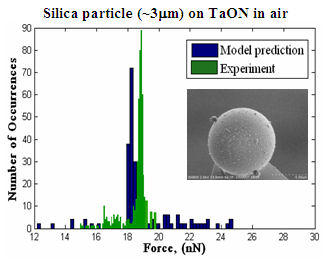You are here: resources › Series › Particle and Thin Film Adhesion › About
Particle and Thin Film Adhesion
Category
Published on
Abstract
 The adhesion of micron and sub-micron scale particles to surfaces is of tremendous interest in a wide range of industrial and civilian applications. We measure directly the adhesion of particles to surfaces using atomic force microscopy and develop experimentally-validated, science-based models for the adhesion. The models consider electrostatic, van der Waals, and hydrophobic interactions for rough, deformable particles with nonuniform geometry adhering to rough deformable surfaces in liquid, gaseous, or vacuum environments.
The adhesion of micron and sub-micron scale particles to surfaces is of tremendous interest in a wide range of industrial and civilian applications. We measure directly the adhesion of particles to surfaces using atomic force microscopy and develop experimentally-validated, science-based models for the adhesion. The models consider electrostatic, van der Waals, and hydrophobic interactions for rough, deformable particles with nonuniform geometry adhering to rough deformable surfaces in liquid, gaseous, or vacuum environments.
These efforts are currently being applied to improve wafer cleaning and polishing processes in the semiconductor industry, to assist in the detection of weapons and explosives, and to facilitate the development and implementation of biomaterials with optimal surface properties.
Cite this work
Researchers should cite this work as follows: